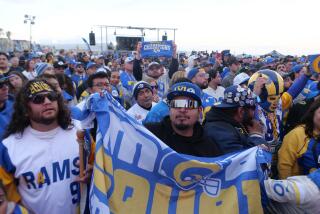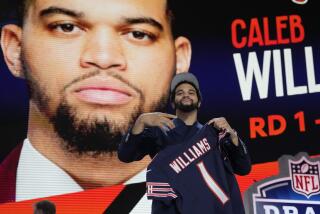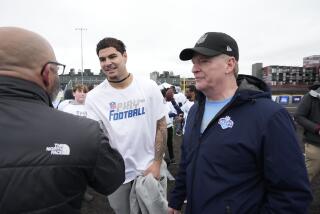NFL DRAFT PREVIEW : It’s the Year of the Drug-Tested Running Back : There Are Many Talented Ballcarriers in This Draft; Some Carry an Asterisk
Sixty-one years ago, Red Grange of Illinois disappointed college football people everywhere when he turned pro and accepted money for playing their game.
A few years later, Jay Berwanger of Chicago was more conventional and, college folks thought, more upright.
Like many other self-respecting college men of his day, Berwanger ignored the NFL when it called.
Specifically, he refused to take it as a compliment when the pros drafted him first in their first draft. He went into private business instead.
As of 1986, pro football seems more respectable than that. It also pays better. The most gifted football-playing college seniors of America, more than 300 of them, will earn millions from the teams that choose them Tuesday in the 12 rounds of the NFL’s 51st annual draft.
The 18-hour selection process is due to begin at 5 a.m. PDT time, when the Tampa Bay Buccaneers pick first. They’re hoping to turn around an ailing franchise in one morning with three picks in the first 1 1/2 rounds.
The Rams and Raiders, both needing quarterbacks, will draft 23rd and 24th, respectively, in recognition of their status as two of the top five teams of 1985.
Summing things up the other day, Art Modell, the Cleveland Browns’ president said:
“This isn’t a very good (draft) crop. It’s hard to find any defensive talent at all after the top five or six players. But there’s a lot of public enthusiasm for the draft anyway--more this year than ever.”
Here are the three major themes of what might be football’s biggest day for pro and college fans between the Super Bowl and the UCLA-Oklahoma game:
--The 5 a.m. spotlight will be on top choice Bo Jackson, the Auburn running back who could become the first Heisman Trophy winner in four years to sign with the NFL. The team leading off the first round, Tampa Bay, will either take him or trade its rights to a team that will.
--As soon as the second round, the pros will begin drafting known drug offenders. About 50 of college football’s top players have tested positive for either marijuana or cocaine--a backdrop which, the teams say, doesn’t rule the users out of pro ball. No new users have been identified.
--In the Year of the Running Back, many of college football’s finest ballcarriers will be drafted early, late, and often.
“We’ve never had so many good running backs,” said Les Miller, director of player personnel for the Kansas City Chiefs. “At least nine backs will go on the first couple of rounds, most of them on the first round. And more will go later.”
TOP PICK
Much of the suspense went out of this draft long ago with these two developments:
--Though still open to trades, Tampa Bay and Atlanta, the teams choosing first and second, have publicly committed themselves to Bo Jackson and Oklahoma nose tackle Tony Casillas.
--Bernie Kosar, who quarterbacked the 1983 Miami Hurricanes to the national championship, elected to graduate last summer, then immediately joined the Browns when they traded for Buffalo’s supplemental draft rights.
This eliminated any Kosar-Jackson contest this week for No. 1.
It also set up a 27-team first round. Although the Bills had won the right to speak first, they won’t speak until the 16th choice, having acquired Cleveland’s first pick in exchange for the supplemental draft choice of last summer.
NFL scouts endorse Jackson unreservedly.
“He will be an immediate star in this league,” Gil Brandt of the Dallas Cowboys said.
Ron Wolf, director of operation for the Raiders, declines to predict the future but remains impressed by Jackson’s past.
“He’s as good coming out (of college) as any back has ever been,” Wolf said.
Dick Steinberg of New England, asked about Jackson’s assets as a running back, said:
“Nobody this big and this fast has ever had everything else, too--the instincts, the vision, cutting ability, the hands. His 40-yard times are unbelievable. Carrying 227 pounds, Jackson averages 4.2 on artificial turf.”
The biggest challenge to the NFL for Jackson could still come from the USFL, whose Birmingham team owns him in that league’s territorial draft.
The USFL has signed the three previous Heisman Trophy winners--Herschel Walker, Mike Rozier and Doug Flutie. It will also bid for Jackson but perhaps not extravagantly enough.
Nor does the NFL expect any baseball club to approach Tampa Bay’s offer, although Jackson plays baseball and wants to delay his career decision until a ballclub can bid for him after the baseball draft in June.
Said Steinberg: “He’s the best to come along since O.J. Simpson.”
D (DRUGS) DAY The NFL takes the position that illegal drug use is a college problem that the pros have merely inherited.
Accordingly, NFL sources have leaked word that a number of drug cases turned up in February--four months before graduation--at a New Orleans tryout camp for leading college prospects.
NFL club executives said some 50 of 350 players at New Orleans tested positive for marijuana and three for cocaine.
But this isn’t enough to keep the NFL from drafting users this week.
“We’ll take it case by case,” said Coach Don Shula of Miami, which has had its share of cases.
Modell said: “The only intelligent thing to do is judge each case on its merits.”
New England Coach Raymond Berry, whose announcement that his team had a drug problem clouded Super Bowl XX on the morning after the game, has yet to declare all-out war on drugs.
“Just because a player made one mistake doesn’t mean he can’t change,” Berry said.
Even San Diego Charger Coach Don Coryell said: “I’d hate for anyone to take a close look into my background as a kid.”
An Eastern scout added: “All the (drug) positives who have talent will be drafted (Tuesday). I don’t think there’s a (pro) team that won’t take a guy just because he flunked a urine test. What’s going to happen is this. The guys who tested positive for cocaine will be dropped a couple of rounds and drafted there. The (others) probably won’t be dropped at all.”
He said most NFL teams are confident that two things are more important than the New Orleans tests. These are, first, the individual player’s drug history, and, second, the quantity of the drugs found in each test.
“A trace of marijuana isn’t necessarily damning,” he said.
Finally, the scout said that although the users won’t be identified on draft day, the information will be leaked eventually.
“Confidentiality is the weakest link in the owners’ demand for random testing,” he said. “The players know the teams can’t keep a secret.”
Miller, the Kansas City personnel executive, said that as the pros prepare for the draft, most clubs are following a drug policy similar to that of the Chiefs.
“We’ll decide every (drug) matter on an individual basis,” he said. “No player is automatically off our board because of a report or an allegation. In our office we see a (drug) report as a bright red flag. It’s something else to check. You have to remember that drugs are part of living in America today. If after a thorough check, his (drug use) seems like an isolated incident, we’ll draft him if we want him.”
THE RUNNERS Ballcarriers could continue to dominate the first round.
At least 15 of those who ran the ball for college teams last fall are believed to have an NFL future, and many of them will be among the first 30 players drafted.
“Reggie Dupard (of SMU) and Garry James (of LSU) are among the most talented to come along in recent years,” New England’s Steinberg said. “James only carried about 10 times a game last year because Dalton Hilliard is on the same team, so James is a bit of a risk. Dupard doesn’t have quite as much ability, but he’s been a bigger producer than James. It’s a tough call.”
James, a 210-pounder with 4.4 speed, and Dupard, who is just a bit smaller and slower, could be among the first 15 players drafted along with Jackson and four other running backs, Ronnie Harmon of Iowa, Rueben Mayes of Washington State, Neal Anderson of Florida and Hilliard.
Miller predicted: “If two of those guys go particularly high, there will be an early run on running backs. Nobody who needs a back will dare wait until the second round.”
Two others who have the ability to be in the run--but who might not be immediately seen--are Keith Byars of Ohio State and Napoleon McCallum of Navy.
Byars is hurt, and McCallum’s pro career will be delayed five years because of Naval service.
Conceivably, Jackson and Byars would have been drafted 1-2 if Byars hadn’t missed most of his last college season with a serious foot injury that still bothers him.
He might be a high choice anyway. His talent is enormous, and some coach may be inspired to gamble for him, bad foot and all.
Those who saw a healthy Byars a year or two ago, sprinting along at 244 pounds, find it hard to believe that even Jackson could be more effective.
Byars’ problem is a reminder, unhappily, that a crippling injury is an ever-present threat to everyone in this sport.
Some scouts call three other running backs first-round prospects. These are Kenneth Davis of TCU, Darryl Clack of Arizona State and fullback John L. Williams of Florida.
Two more who seem likely to make it on at least the second round are Allen Pinkett of Notre Dame and fullback Anthony Toney of Texas A&M.;
Such small-college products as Christian Okoye of Azusa Pacific and Vance Mueller of Occidental also have NFL potential, in the view of some NFL scouts.
And many other runners will turn up as the drafting winds down Tuesday night.
Jerry Jones of Cincinnati, the analyst who has rated draft prospects for many years, said: “This is the most talent I’ve ever seen at running back.”
More to Read
Go beyond the scoreboard
Get the latest on L.A.'s teams in the daily Sports Report newsletter.
You may occasionally receive promotional content from the Los Angeles Times.










